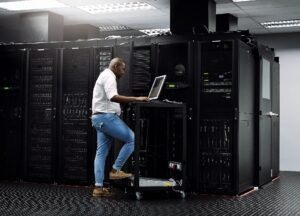Gartner’s Data Center Conference 2012 (2nd – 6th December 2012, Las Vegas Nevada) looks like it’s going to be a stimulating couple of days in the desert. What I like about this event is that it manages to bring together IT and facilities professionals by addressing the concerns of both groups. As a result it’s become one of the biggest conference and expos anywhere in the world.
If that’s not a big enough draw for you, I’ll be filling a guest-spot during Jason Waxman of Intel’s “Transforming Enterprise IT to IT-as-a-Service” Solution Provider Session! These are analyst-moderated panels where vendors and end users share their experiences and “lessons learned” from real implementations. It will be interesting to see how this works In the case of ITaaS because it really is brand new – you only have to look at the length of its Wikipedia entry to see how new it is. The analysts haven’t even added to it yet!
The emergence of cloud computing and to a certain extent, a burgeoning outsourcing market puts a new pressure on the enterprise data center. Whereas in the past the enterprise data center pretty much did what it did and you had to live with that, suddenly a new era of transparency will allow the internal customer to judge for him- or herself, whether the value of the IT service provided actually justifies the cost.
Now maybe that means that the enterprise customer doesn’t quite have the mobility to simply up sticks and move the IT load to another service provider, but at least there will be KPIs in the public domain to provide a benchmark and set expectations. There’s a good opportunity to close a loop here – for the CIO to prove the commercial worth of the enterprise data center(s), and for the other members of the executive team to be able to make an objective assessment based on data.
As the abstract goes, the future “IT-as-a-Service” requires the data center to become the system, while the servers, storage and networking become its components. In fact, at Schneider Electric we’d go a step further and say that the equipment which provisions power and cooling, plus the space and networking should also be counted as components of the data center as a system. The much talked about gap between IT and facilities starts to look like it really has been bridged.
Those of you who have followed the development of our StruxureWare for Data Centers software are probably aware of the integration with Intel’s Data Center Manager offering. For anyone looking at the holistic efficiency of their facilities, such integrations are important not just from the point of view of functionality, but also for future-proofing the applications being used and managing risk. But speaking personally, I’m really glad that Intel has joined the DCIM market as they bring legitimacy. It’s as if the world leaders in microprocessor technology are effectively saying that this stuff is too important to be ignored.
Jason Waxman will be sharing Intel’s views on this transformation and how the use of Intel based technology can help deliver an effective IT-as-a-Service solution to meet the evolving needs of the enterprise. For my part, I’ll be talking about how Schneider Electric’s data center technology can help ensure the efficiency, availability and manageability of the infrastructure, from the UPS right up to the hypervisor, and make it transparent across the corporate domain. I look forward to seeing you in Las Vegas on the 4th December at 1:45pm – if you want to meet up, tweet me @brogaards. It should be a blast!



